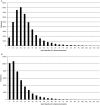Age, sex, and hospital factors are associated with the duration of cardiopulmonary resuscitation in hospitalized patients who do not experience sustained return of spontaneous circulation
- PMID: 25520328
- PMCID: PMC4338690
- DOI: 10.1161/JAHA.114.001044
Age, sex, and hospital factors are associated with the duration of cardiopulmonary resuscitation in hospitalized patients who do not experience sustained return of spontaneous circulation
Abstract
Background: Variability in the duration of attempted in‐hospital cardiopulmonary resuscitation (CPR) is high, but the factors influencing termination of CPR efforts are unknown.
Methods and results: We examined the association between patient and hospital characteristics and CPR duration in 45 500 victims of in‐hospital cardiac arrest who did not experience return of spontaneous circulation (ROSC) and who were enrolled in the Get With the Guidelines registry between 2001 and 2010. In a secondary analysis, we performed analyses in 46 168 victims of in‐hospital cardiac arrest who experienced ROSC. We used ordered logistic regression to identify factors associated with CPR duration. Analyses were conducted by tertile of CPR duration (tertiles: ROSC group: 2 to 7, 8 to 17, and 18 to 120 minutes; no‐ROSC group: 2 to 16, 17 to 26, 27 to 120 minutes). In those without ROSC, younger age (aged 18 to 40 versus >65 years; odds ratio [OR] 1.81; 95% CI 1.69 to 1.95; P<0.001), female sex (OR 1.05; 95% CI 1.02 to 1.09; P=0.005), ventricular tachycardia or fibrillation (OR 1.50; 95% CI 1.42 to 1.58; P<0.001), and the need to place an invasive airway (OR 2.59; 95% CI 2.46 to 2.72; P<0.001) were associated with longer CPR duration. In those with ROSC, ventricular tachycardia or fibrillation (OR 0.89; 95% CI 0.85 to 0.93; P<0.001) and witnessed events (OR 0.87; 95% CI 0.82 to 0.91; P<0.001) were associated with shorter duration.
Conclusions: Age and sex were associated with attempted CPR duration in patients who do not experience ROSC after in‐hospital cardiac arrest but not in those who experience ROSC. Understanding the mechanism of these interactions may help explain variability in outcomes for in‐hospital cardiac arrest.
Figures


Comment in
-
Measuring what matters: CPR quality and resuscitation outcomes.J Am Heart Assoc. 2014 Dec;3(6):e001557. doi: 10.1161/JAHA.114.001557. J Am Heart Assoc. 2014. PMID: 25520330 Free PMC article. No abstract available.
References
-
- Ebell MH, Afonso AM. Pre‐arrest predictors of failure to survive after in‐hospital cardiopulmonary resuscitation: a meta‐analysis. Fam Pract. 2011; 28:505-515. - PubMed
-
- Field JM, Hazinski MF, Sayre MR, Chameides L, Schexnayder SM, Hemphill R, Samson RA, Kattwinkel J, Berg RA, Bhanji F, Cave DM, Jauch EC, Kudenchuk PJ, Neumar RW, Peberdy MA, Perlman JM, Sinz E, Travers AH, Berg MD, Billi JE, Eigel B, Hickey RW, Kleinman ME, Link MS, Morrison LJ, O'Connor RE, Shuster M, Callaway CW, Cucchiara B, Ferguson JD, Rea TD, Vanden Hoek TL. Part 1: executive summary: 2010 American Heart Association Guidelines for Cardiopulmonary Resuscitation and Emergency Cardiovascular Care. Circulation. 2010; 122:S640-S656. - PubMed
-
- Chan PS, Krumholz HM, Nichol G, Nallamothu BK. Delayed time to defibrillation after in‐hospital cardiac arrest. N Engl J Med. 2008; 358:9-17. - PubMed
Publication types
MeSH terms
Grants and funding
LinkOut - more resources
Full Text Sources
Other Literature Sources
Medical

